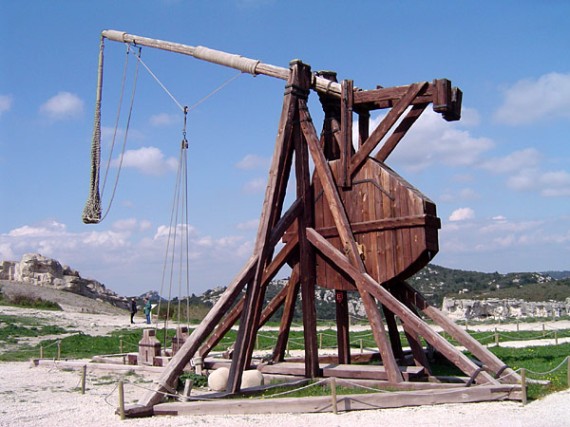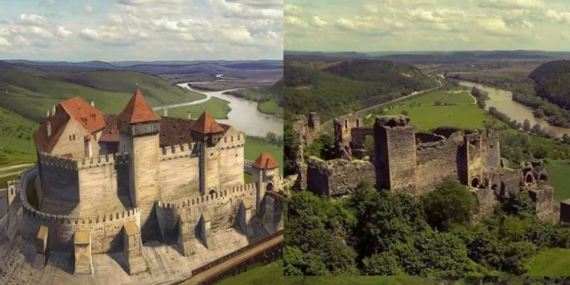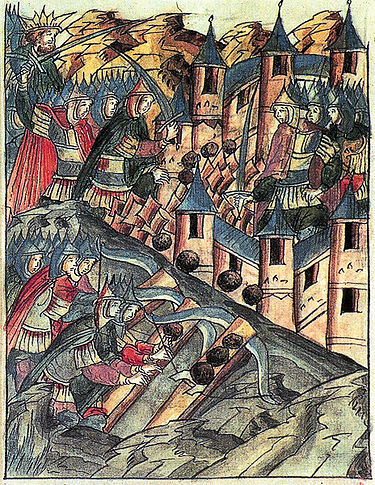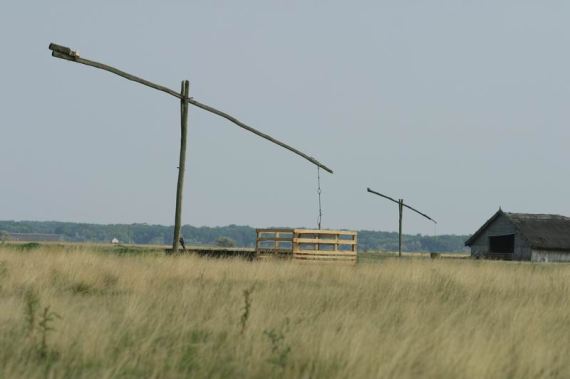[By Chuck Almdale]
[NOTE: If maps, pictures and legends don’t display properly in your email, go to the blog. Interactive Google maps may not work in your email but will work on the blogsite. There is a link at the bottom to the entire Mongol Empire & Rus’ series.]
Looks crowded, doesn’t it, but locations differentiate as you zoom in. Interactive Google MyMap above shows all locations for Rus’ 9th-13th centuries and Mongol Eastern and Central European invasion 1236-42 CE. Click on any marker or line for description. If map doesn’t display properly in your email, go to the blog.

Calligraphy of Mongolian poem “White cloud”
composed and brush-written by Injinash Banchinval.
Source: Wikipedia – Mongolian script
By the end of March the days are clearly lengthening and the nights are warmer. The insects grow more numerous, bloodsuckers are busy, crickets chirp. A small owl hoots from a nearby copse. The men and beasts are settling down, tail-swishing horses to their grass, men to their korkkhog, gurultai shul, and kumis. Today they fought another battle against another stone fortress. Once again the results were the same and everyone is tired. They’d been fighting almost non-stop since crossing the ice to Buda on the great holy day of the Christians. But conquest takes no holidays. Except for the summer and fall, of course.

In his ger, Baghatur Subutai sits at his work desk on his favorite, thickest carpet, quill in hand, scratching on a sheet of vellum by the light of the lamp. He is updating his battle list: towns, days of battle, men lost, defenders killed, loot taken, fortifications encountered, slaves taken, horses lost, food remaining. Lastly is his personal scale of battle site gain versus cost. His usual end-of-day routine. This latest town, as useless as it was, doesn’t really change the overall picture. Yes, it is that bad. He shakes his head, swears, and has another drink of kumis. The kumis, at least, is reliably good.
I quietly peer over his shoulder but cannot read Mongolian script. He notices me, a ghostlike wraith. He is neither surprised nor frightened. He greets me. I understand his language although I don’t know how or why.
“I see you; you cannot hide from me. From where and whence do you come, spirit? Asia? Europe? The lands beyond the western sea? Never mind, you are not the first, nor – I suspect – the last. This has been going on for years. What do you wish to know?”
My question, I reply, is the great question: what for centuries everyone has wanted to know. What has been decided about the Great Western Invasion? What direction will they go; most importantly, why? Of course, in our time we know what they did, but why?, why? — that is still guesswork. So much was lost or never written down. I say nothing about that. The possibility and danger of influencing the past still remains a temporal uncertainty.
“Ah, I see you are from Europe, or even farther west. Only such visitors ask that question. When they come from India or China or Africa, their concerns lie elsewhere. Yes…it has been decided. Tonight, in fact, just before you arrived. Perhaps you knew that already. I have seen this coming for many weeks, but one does not lightly give up the task of fulfilling the avowed desire of Genghis Khan. Our commission from Tengri was that the earth was promised to Temüjin. Did Tengri changed his mind? Perhaps Tengri knew that only by truly believing the world was ours and we need simply reach out and take it would we get this far. Perhaps Tengri’s intentions were other than his spoken word, and this apparent failure was exactly the success he planned. Or perhaps other roads in other directions must be traveled first. I don’t know. No one knows. Only Tengri knows.”
“I am a baghatur, a general, the top general of over 100,000 men. My spies gather information, I plan the strategy, lay out the tactics and battle plans. After the battles I record the results. That’s one of my secrets. You cannot plan your next step without knowing exactly has happened and where you stand. Otherwise you are blind. Many leaders blunder on, hoping for success, praying for success, yet not planning for success. I have won battle after battle by planning our enemy’s losing steps for them, and I watch them when we snatch their victory from their hands. I will not be fooled into laziness or surprised by defeat. If I am about to lose, I will see it coming.”
“And,” he added, “it is coming. Therefore we will leave before it arrives. Withdrawal is not defeat. Death without gain is defeat. We will withdraw, regroup, and set out in another direction. Here, look at this chart. I will explain. But before that, I must send a messenger to Batu. We gave ourselves until the end of March to see if things would improve. He awaits my conclusions. If he follows my advice, and I’m sure he will, we will withdraw. We will merge our armies in Bulgaria, a land as yet unknown to us. We will see what we find there, and then we will make our next decision.”
He took up another sheet and began writing his message to Batu. I looked at the chart and was able to understand some of its import, that which I mentioned above. I got the gist, but names were unfamiliar, meanings elusive. The characters began to swim before my eyes, they telescoped out, they’re 800 years away, the ger’s interior begins to vibrate and Subutai’s words begin to echo and fade, like someone talking down a metal pipe from far away. Most of it is lost, but using what little has come down to us today, I’ll give you a fragment of what Subutai wrote. The map below will tie it together.
Green Castles: 27 fortifications attacked but not taken.
Red Castles: 5 stone fortifications taken and sacked.
Orange Battle Sites: 6 sacked, fortifications unknown or uncertain.
Blue Battle Sites: 3 sacked but unfortified.
Purple Question Marks: 2 attacked, details unknown.
Gray Question Marks: 2 battles/sieges of doubtful occurrence.
Siege Analysis
Below is a list of attacks on fortifications and towns in Hungary, Slovenia, Croatia, and Austria. It is limited to sieges and city battles described or — when little is known about them or reports conflict — at least mentioned in earlier installments. To make this easier, I’ve keyed them to the interactive map above. The list does not include the following battles in the field, as they were not attempts to pillage: Sajó River, Morava River, Brașov, and the Lika massacre. There are 45 listed sieges or attacks, which break down as follows (listed roughly north to south and west to east within each group. The map shows:
27 Green Castles
Stone Fortifications Attacked, Not Taken (towns, abbeys, castles or fortresses), adjoining unfortified areas pillaged: Trenčín, Pressburg, Nyitra, Komárom, Fülek, Abaújvár, Újhely, Sopron, Léka, Moson, Győr, Pannonhalma, Esztergom, Vasvár, Zalavár, Tihany, Veszprém, Székesfehérvár, Nagyvárad, Arad, Tamashida, Szeged, Csanád, Kalnik, Split, Trogir, Klis.
5 Red Castles
Stone Fortifications Sacked (towns, abbeys, castles or fortresses): Pest, Igriș Abbey, Küküllővár, Nagyszeben, Orljava.
Out of 45 total sieges or attacks, we are reasonably certain 32 were upon fortified structures and 27 of those withstood the siege and were not taken. Of the five fortifications successfully taken, at least one was a church (Pest) and one an abbey (Igriș). This leaves the following 13 less-than-certain sieges or town battles.
6 Orange Battle Sites
Sacked, Fortifications Unknown or Uncertain: Korneuburg, Vác, Beszterce, Kolozsvár, Alba Iulia, Zalaegerszeg.
3 Blue Battle Sites
Sacked Unfortified: Radna, Buda, Zagreb.
2 Purple Question Marks
Attacked, Details Unknown: Pécs, Kerc.
2 Gray Question Marks
Battles/sieges Uncertain as to whether battle actually occurred: Čazma, Šibenik.
Additional research might bring us clarification on uncertain battles. A quick analysis shows that 84% (27 of 32) known stone fortifications could not be taken. If we include the 6 towns sacked with uncertain fortifications, and assume they were fortified, the percentage of untaken fortifications drops to 71% (27 of 38). Therefore, at best, against stone fortifications, the Mongols succeeded only 29% of the time, and 16% of the time may be a closer figure. Even if all the remaining 13 uncertain battles (which includes the 6 towns mentioned above) were successful sieges of stone fortifications (and we know for certain some were not), the very best they could claim was 18 successes out of 45 sieges, a 40% success rate. That might be excellent for you or me, if we chose to make a career out of pillaging, but not for the Mongol army. Actually, it’s pathetic.
The Ger Fades
And while the letters began to waver and dance before my eyes, Subutai glances up, then eyes me quizzically.
“You are fading. I can see the wall through you. I suspect you soon will leave, as have all those who came before you. Here, I will read what I now write to Batu Khan. Perhaps that will tell you what you came to learn.”
Batu Khan:
As we previously discussed, it is now the end of March and I have recorded our results. As we previously suspected, this invasion is not worth the effort. Too many stones, too little plunder, too many crossbows, too many dead. Advise we stop all battles and return east. Meet in Bulgaria, there to replan.
Honorably yours, Baghatur Subutai.
And with that last glimpse of Subutai and the fading sound of his words, the ger, the men and horses and Hungary itself all faded away and I found myself back in the 21st century, returned from a most interesting voyage.

Spread of the Mongol Empire 1206-1294 CE.
Source: Wikipedia – Mongol Empire
Interactive Google MyMap above shows all locations for Central Asian conquest 1220-1224 CE. Click on any marker or line for description. If map doesn’t display properly in your email, go to the blog.
Entire Mongol Empire & Rus’ Series: Click Here
First Installment: Why didn’t the Mongols Conquer Europe in the 13th Century?
Previous Installment: Conclusions || Mongol Empire CXIV
This Installment: Subutai – A Fantasy || Mongol Empire CXV
Source
Deep ditches and well-built walls: a reappraisal of the Mongol withdrawal from Europe in 1242; Pow, Lindsey Stephen, 2012; Department of History, University of Calgary, Calgary, Canada. Link to free thesis PDF.
















You must be logged in to post a comment.